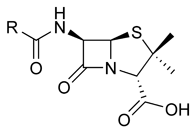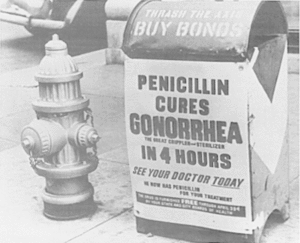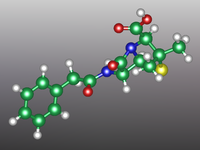Bicillin
Penicillin refers to a group of β-lactam antibiotics used in the treatment of bacterial infections caused by susceptible, usually Gram-positive, organisms. The name "penicillin" can also be used in reference to a specific member of the penicillin group. Penicillins have the molecular formula R-C9H11N2O4S, where R is a variable side chain. more...
History
Penicillin was originally isolated from the Penicillium chrysogenum (formerly Penicillium notatum) mould. The antibiotic effect was originally discovered by French medical student Ernest Duchesne studying Penicillium glaucum in 1896, but his discovery was ignored by the Institut Pasteur. Another Institut Pasteur scientist, Costa Rican Clodomiro Picado Twight was the first to record the antibiotic effect of Penicillium in 1923.
The serendipitous discovery was finally attributed to Scottish scientist Alexander Fleming in 1928, who noticed a halo of inhibition of bacterial growth around a contaminant blue-green mould on a Staphylococcus plate culture. Fleming concluded that the mould was releasing a substance that was inhibiting bacterial growth. He grew a pure culture of the mould and discovered that it was Penicillium notatum – he later named the bacterial inhibiting substance "penicillin" after the Penicillium notatum that released it. Fleming was convinced after conducting some more experiments that penicillin could not last long enough in the human body to kill pathogenic bacteria and stopped studying penicillin after 1931. It would prove to be the one of the discoveries that changed modern medicine. In 1939, Australian scientist Howard Walter Florey and a team of researchers at University of Oxford made significant progress in showing the in vivo bacteriacidal action of penicillin. On 1942-03-14 John Bumstead and Orvan Hess became the first in the world to successfully treat and save a patient using penicillin.
During World War II, penicillin made a major difference in the number of deaths and amputations caused by infected wounds amongst Allied forces. Availability was severely limited, however, by the difficulty of manufacturing large quantities of penicillin and by the rapid renal clearance of the drug necessitating frequent dosing. Penicillins are actively secreted and about 80% of a penicillin dose is cleared within three to four hours of administration. During those times it became common procedure to collect the urine from patients being treated so that the penicillin could be isolated and reused. (Silverthorn, 2004)
This was not a satisfactory solution, however, so researchers looked for a way to slow penicillin secretion. They hoped to find a molecule that could compete with penicillin for the organic acid transporter responsible for secretion such that the transporter would preferentially secrete the competitive inhibitor. The uricosuric agent probenecid proved to be suitable. When probenecid and penicillin are concomitantly administered, probenecid competitively inhibits the secretion of penicillin, increasing its concentration and prolonging its activity. The advent of mass-production techniques and semi-synthetic penicillins solved supply issues, and this use of probenecid declined. (Silverthorn, 2004) Probenecid is still clinically useful, however, for certain infections requiring particularly high concentrations of penicillins. (Rossi, 2004)
Read more at Wikipedia.org




